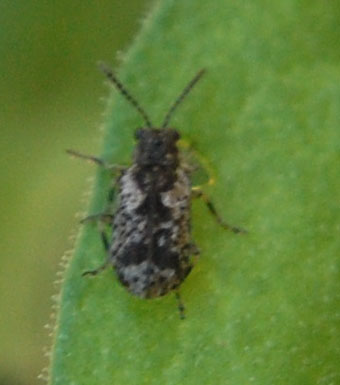Mining Leaf Beetle
Monoxia sordida

On
Arizona Desert Thornbush (Lycium excertum) in  a xeriscape garden in Phoenix, Arizona, Oct. 2008. They are a favorite food for
Verdins. Active little birds, verdins are welcome in my garden and they
must eat - I should not spray the beetles! An Orange-crowned Warbler also
visits the wolfberry bush to nab the little beetles.
a xeriscape garden in Phoenix, Arizona, Oct. 2008. They are a favorite food for
Verdins. Active little birds, verdins are welcome in my garden and they
must eat - I should not spray the beetles! An Orange-crowned Warbler also
visits the wolfberry bush to nab the little beetles.
Chrysomelidae -- Leaf Beetle Family
These beetles lay their eggs on the leaves of semi-succulent plants such as wolfberry (Lycium; Solanaceae), saltbush (Atriplex; Chenopodiaceae) or sagebrush (Artimesia; Asteraceae). Upon hatching the minute grub tunnels through the upper and lower leaf surface creating a translucent tunnel. Eventually most of a whole leaf is consumed from within before the grub-larva pupates and later emerges as an adult beetle. The beetles are small, just a few millimeters long and somewhat flattened. Monoxia of one or more species have been found mostly in the western USA. Thick, succulent leaves are one strategy for plants to survive desert environments and by remaining inside the moist leaf during development the Monica larvae also avoid desiccation.